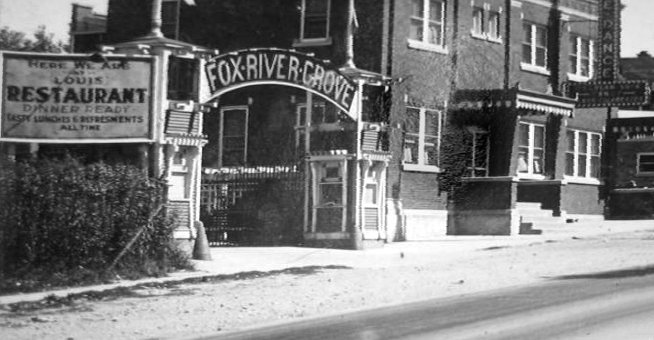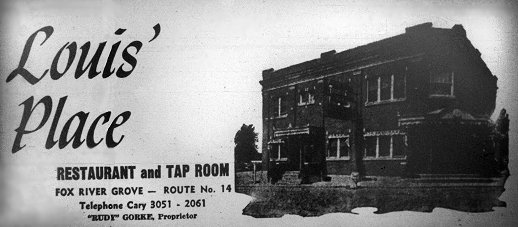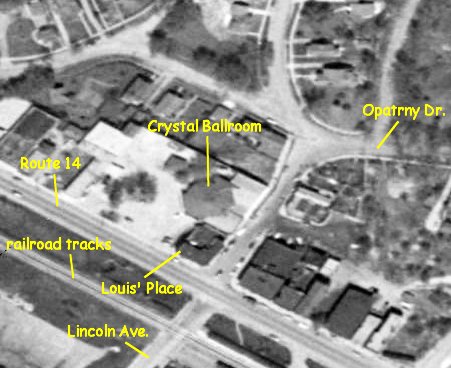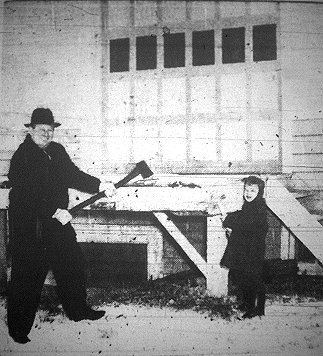| ----- | Louis' Place Crystal Ballroom Fox River Grove, IL | ----- | ||
|
Louis Cernocky was born in Czechoslovakia and came to the United States at the age of 21. He worked as a harness maker in Chicago before moving to Fox River Grove with his wife and sons in 1919. He purchased block 12 in the First Addition to Fox River Grove. The land was previously known as the Johnson farm, and was located on prime real estate at the corner of what is now Lincoln Avenue and Route 14. There was a building on the corner, which Cernocky remodeled in 1920 and opened as the Fox River Grove Inn - Louis' Place. Bohemian dishes were the specialty of the house, and Mary Cernocky's Bohemian cooking became famous. Mayor Anton Cermak came all the way from Chicago just to eat there. In 1921, Cernocky added a small retail section to the building, and in 1922 he subdivided the land and named it Cernocky's Subdivision of Block 12. In 1923, an eight-sided dance hall was built behind the restaurant. It was first known as the Fox River Grove Pavilion and Cernocky's Pavilion before becoming the Crystal Ballroom. A flashing electric sign adorned the very top, showing a golden pheasant with many gorgeous colors. It could be seen for miles around. | ||||


|
In 1925, the restaurant was expanded and a second floor was added. The first floor now included a dining room, kitchen, porch and soft drink parlor. The second floor had a two-bedroom apartment with kitchen, living room and drawing room. At the northeast end, three shops were available for rent. In addition to Cernocky's wife and a staff of waitresses, the restaurant was manned by Cernocky's sons, Edward and Louis Jr. | ||||


|
Prohibition was in effect between 1920 and 1933. During this time, the manufacture and sale of alcoholic beverages was illegal. Like many restaurant and roadhouse owners of the day, Louis Cernocky didn't always obey the law. Obtaining bootleg liquor put him in contact with the Chicago mob, and he became a liquor distributor for Al Capone's gang. Louis' Place became a friendly haven for Chicago-based gangsters. Prohibition agents raided the restaurant from time to time. The buildings were built on the old foundations and cisterns of the Johnson farm, which led agents to believe that there were secret underground vaults beneath the surface. | ||||

|
The Crystal Ballroom was the most glamorous dance venue in the area. During the 1920s and 1930s, the ballroom hosted such bands as Glenn Miller, Coon-Sanders, Louis Panico, Frankie Masters, Art Kassel, Fred Waring, Wayne King and Guy Lombardo. In 1932, there was dancing every Saturday night, with the price of admission being 50c for men and 25c for ladies. The ballroom also hosted New Year's Eve celebrations, various banquets and the annual Firemen's Dance. Louis Cernocky's connections to organized crime grew stronger in the early 1930s. Several high-profile gangsters became regulars at the establishment. Cernocky treated them royally, and was always ready with a hot meal and a bed for the night if they needed to "hide out" for a day or two. Frequent visitors included "Baby Face" Nelson, John Dillinger, Alvin "Creepy" Karpis, "Ma" Barker and her son Freddie, as well as various wives and girlfriends. In April 1934, the Dillinger gang regrouped at Louis' Place following a police raid in St. Paul and the arrest of Dillinger's girlfriend. Cernocky offered them rooms for the night and suggested that the Little Bohemia Lodge in Wisconsin would make an ideal hideout. The next day, armed with a letter of introduction written by Cernocky, the gang drove 400 miles to the lodge. Acting on a tip, FBI agents raided the lodge, but were only successful in apprehending three wives and girlfriends. | ||||

|
Prohibition was repealed in 1933. A bar was added to the restaurant, and the establishment became known as Louis' Place Restaurant and Tap Room. A 1934 chattel mortgage provides us with a glimpse of the premises and decor: bar room: two mounted deer heads, one mounted moose head, one set of mounted moose horns, one set of mounted deer horns, six mounted birds, two tables, eight chairs, one cherry-top bar, four cuspidors. porch: four large tables, one rattan settee with cushions, 40 chairs. dining room: two mounted pheasants, 13 tables, 52 chairs, eight cuspidors, one back bar with cigar and candy case, one telephone booth, one 24-foot marble-top soda fountain, one electric "Barbecue" sign, one piano, one ceiling fan. soft drink parlor: 14 tables, 56 wire chairs, one 18-foot soda fountain, two malted milk machines, four coat trees, one glass candy case, one glass cigarette case, one cigar case, one Wurlitzer piano. ballroom ticket office: one floor-polishing machine, one music roll case containing 50 music rolls for the Wurlitzer piano. ballroom: one baby grand piano, one microphone with "broadcaster," three tables, 12 wooden chairs, 150 wire chairs, two ceiling fans, one large electric suction fan, five small fans, two mounted Mallard ducks. The bar room, dining room and soda fountain were fitted with radio speakers providing piped-in music. | ||||

|
Louis Cernocky passed away in September 1934 at the age of 49. Heavily in debt, Mary Cernocky deeded the restaurant and ballroom property to her sons. Edward Cernocky took over the operation of the restaurant while Mary Cernocky managed the soft drink parlor. In 1935, the business gained some much-needed parking space behind the building when the "Fox River Grove" arch was removed, along with some fencing and bushes. The ballroom added a floor show and amateur night to their regular schedule of weekly dances. | ||||

|
In the late 1930s, the restaurant and ballroom were the frequent targets of crime. In 1936, five armed men tried to rob the restaurant, but were unsuccessful when employees grappled with them and forced them to flee in their two getaway cars. A more serious incident occurred in 1939. A fire of suspicious origin broke out in the ballroom, and a night watchman was placed on guard while the fire was being investigated. A week later, six men came during the night, and while four of them saturated the ballroom with kerosene, the other two abducted the night watchman and visiting fire marshall at gunpoint. They fled in their cars and drove to Barrington, while two bombs were detonated in the ballroom. The captives were released near Palatine. The resulting fire from the explosions gutted the ballroom, but didn't damage the roof or the adjoining shops. The interior of the ballroom was repaired, but the ballroom never reopened for dancing. In 1941, Louis Jr. became the owner of the entire complex when Edward's portion of the property was deeded to him. The Depression and early 1940s were difficult years for the Cernockys, and in 1942 Mary Cernocky was forced to declare bankruptcy. Louis Jr. sold the business to Peter Herbst, and this was the beginning of a long line of different proprietors, among them Louis Pinocci, Frank Garrity, Mr. La Beau, Paul Ditt, Elizabeth Berntsen and Rudy Gorke. During this time, the restaurant continued to operate under the name Louis' Place. In 1951, Louis Jr. reclaimed ownership of the business and sold it to Patrick and Jeanette Carbon, who renamed it Carbon's Place. In 1954, it became Panker's Restaurant and Lounge, owned by Bill and Jeanette Panker. In 1958, Bill Panker teamed up with Jack Mathews to open the last restaurant to be located in the building, the J & B Lounge. The former ballroom was converted into a factory, and in the 1950s it was rented by Sewed Products Company, the Grigsby-Allison Company and Candle Craft. A new retail addition was built in 1952 and became the home of Grove Radio & Electric, a general merchandise store and the Post Office. Later in the decade, a bakery, clothing store, dental office and the Skouland Pharmacy were also located there. In 1958, the restaurant and retail buildings were destroyed by fire. The Skouland Pharmacy and Post Office were moved to temporary quarters. Louis Jr. announced plans to build a one-story retail building in place of the old one. | ||||


| After the fire, all that remained of the complex was the ballroom/factory building. This was torn down in 1961, and a small strip mall and parking lot were built on the property. The first tenants in the new building were the Post Office, Public Library, Personally Yours Beauty Shop, Grove Maid Coin Laundry and Skouland Drug Store. In 1965, Louis Cernocky Jr. deeded the land to Fox River Grove Properties Inc. The Public Library purchased their unit in 1976, and remained in the building until 2000, when they moved to their new location south of the railroad tracks. The shopping center and parking lot, with the exception of the library unit, became the Lincoln Street Resubdivision in 1991.
| ||||
return to:
<<< Fox River Grove History
|
| ||